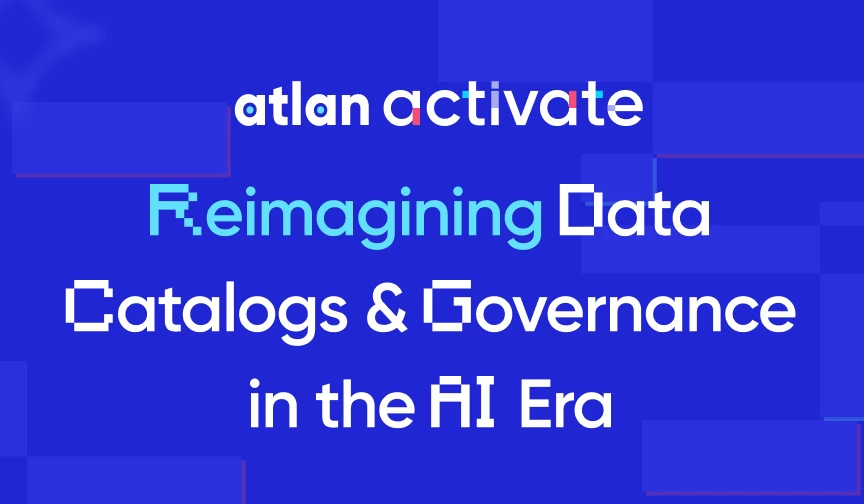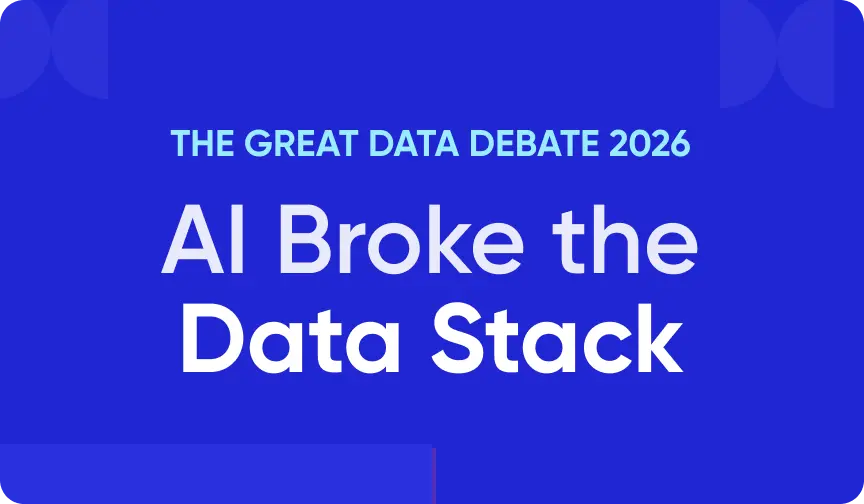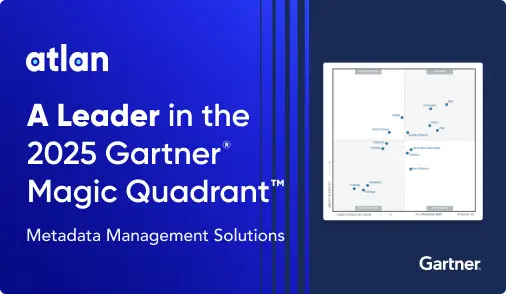Data Governance Solutions: Emerging Trends & Must-Have Product Qualities in 2025
Share this article
As organizations navigate increasing data complexity and AI adoption, data governance solutions must evolve to help build a trusted, business-aligned, and future-proof data estate.
See How Atlan Simplifies Data Governance ✨ – Start Product Tour
In this article, we explore the latest trends shaping data governance, key solution capabilities, and real-world case studies from enterprises using Atlan for modern data governance.
Table of Contents
Permalink to “Table of Contents”- Data governance solutions: Emerging trends and insights in 2025
- Data governance solutions: 4 product qualities to look for in 2025
- Data governance solutions: How Atlan’s metadata control plane is built for change
- Data governance solutions: Bottom line
- FAQs about data governance solutions
- Data governance solutions: Related reads
Data governance solutions: Emerging trends and insights in 2025
Permalink to “Data governance solutions: Emerging trends and insights in 2025”The rise of AI and automation is fundamentally reshaping technology investments in enterprises. However, Gartner predicts that, by 2027, 60% of organizations will fail to realize the anticipated value from their AI investments due to incohesive governance frameworks.
That’s because no matter how sophisticated your AI models are, their success hinges on a strong governance foundation. Without it, AI-driven insights become unreliable.
As the keynote speaker at Gartner D&A Summit 2025 cleverly noted:
“AI is the cake, governance is the salad.”
Although data governance maturity in companies has been rising, ensuring success requires a modern approach to data governance. Modern enterprises grapple with increasingly diverse systems, users, data sources, and use cases. An effective data governance solution for such enterprises should account for this diversity of people, process, and technology.
Gartner echoes these sentiments by emphasizing the need for data governance to enable, encourage, embed, and support a symbiotic relationship between people and technology.
So, future-forward data governance solutions act as metadata control planes for your data value chain and people – turning data products, analytics products, and AI products into business value.
With these principles in mind, let’s dive into the four essential capabilities of a future-ready data governance solution.
Data governance solutions: 4 product qualities to look for in 2025
Permalink to “Data governance solutions: 4 product qualities to look for in 2025”A data governance solution that can adapt to the rapidly evolving AI and data landscape must have these core capabilities:
- A unified policy center: Unifies fragmented policies, ensuring real-time policy enforcement and visibility across the data stack.
- Automation and AI: Eliminates manual bottlenecks, accelerating compliance and governance at scale.
- Open-by-design: Ensures interoperability across evolving AI, analytics, and cloud ecosystems.
- Personalized data marketplace: Enables adoption across diverse teams and business functions.
Let’s break down each capability.
1. A unified policy center for data governance policies
Permalink to “1. A unified policy center for data governance policies”A unified policy center provides visibility into data governance policies – covering data quality, privacy, security, lifecycle, ethics, and metadata models. This helps you ensure compliance by authoring, approving, and connecting your data assets to data governance policies.
So, look for data governance solutions offering built-in policy centers, which provide:
- A top-down view of policy coverage across your data estate
- Granular tracking of assets being governed over time
- Metadata filters to review policies by scope, investigate overlapping policies, and more
- Instant alerts for non-compliance incidents
- A single place to review pending approvals of data governance workflows, monitor ungoverned or non-compliant assets and take action on expiring policies at scale
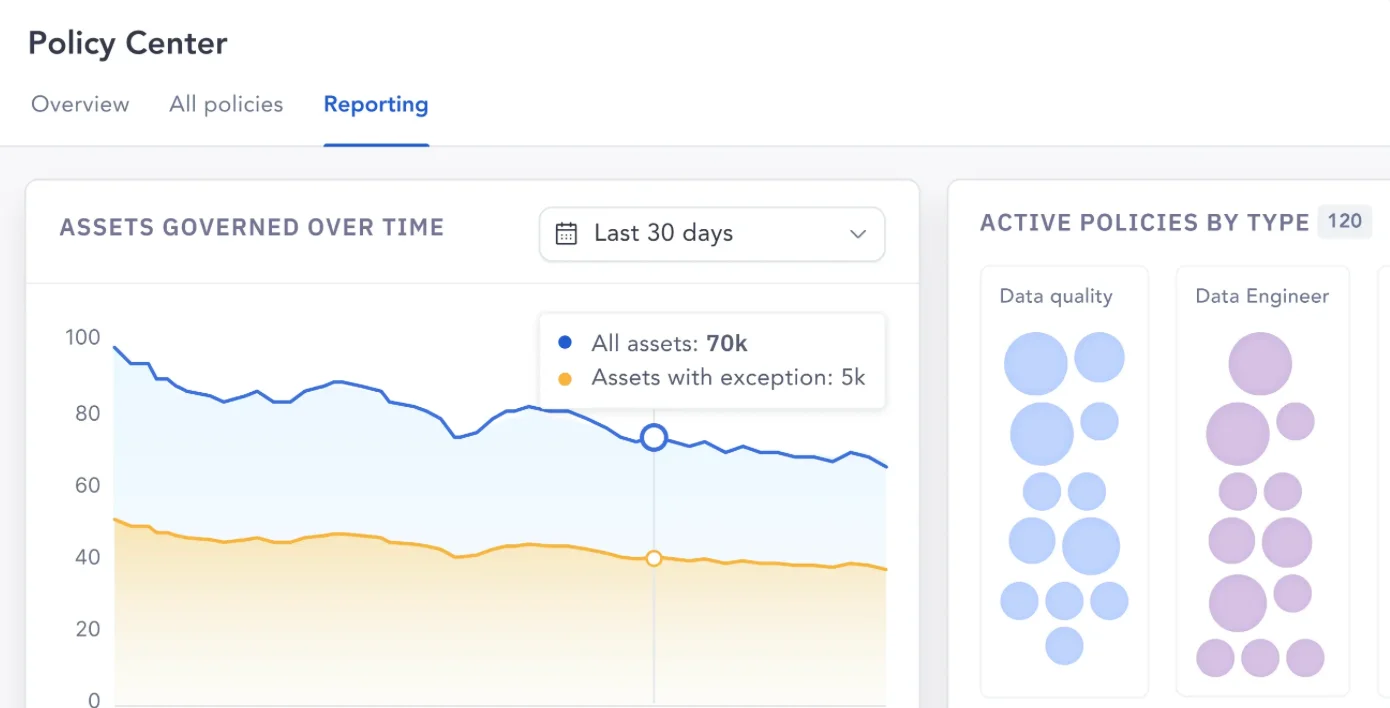
An example of a transparent policy center to monitor and report data governance policies across your data estate - Source: Atlan.
2. Automation and AI to scale governance efforts
Permalink to “2. Automation and AI to scale governance efforts”A data governance solution embedded with automation and AI can accelerate data governance initiatives and free up valuable time.
For instance, AI-assisted policy creation can draft compliance policies—including purpose, scope, and exceptions—within minutes. This frees up the time data stewards spend on operations and allows them to focus on building more value.
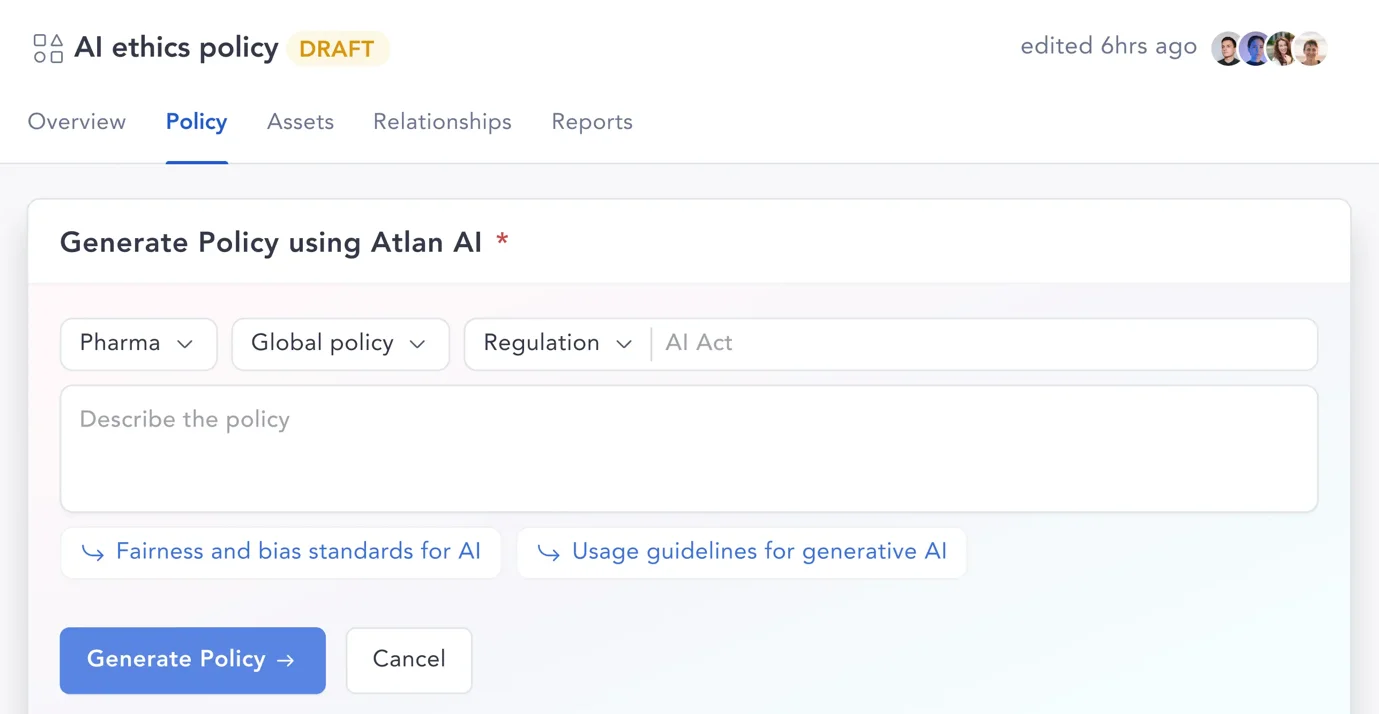
An example of AI-assisted policy creation - Source: Atlan.
You can also set up rule-based automation workflows to update metadata–asset descriptions, owners, tags, domains, certificates, custom metadata–in bulk.
Let’s say your enterprise needs to transfer ownership of several data assets. Instead of your data team manually updating the ownership of each and every asset, you can create a playbook to automate this process and update the metadata of your assets at scale.
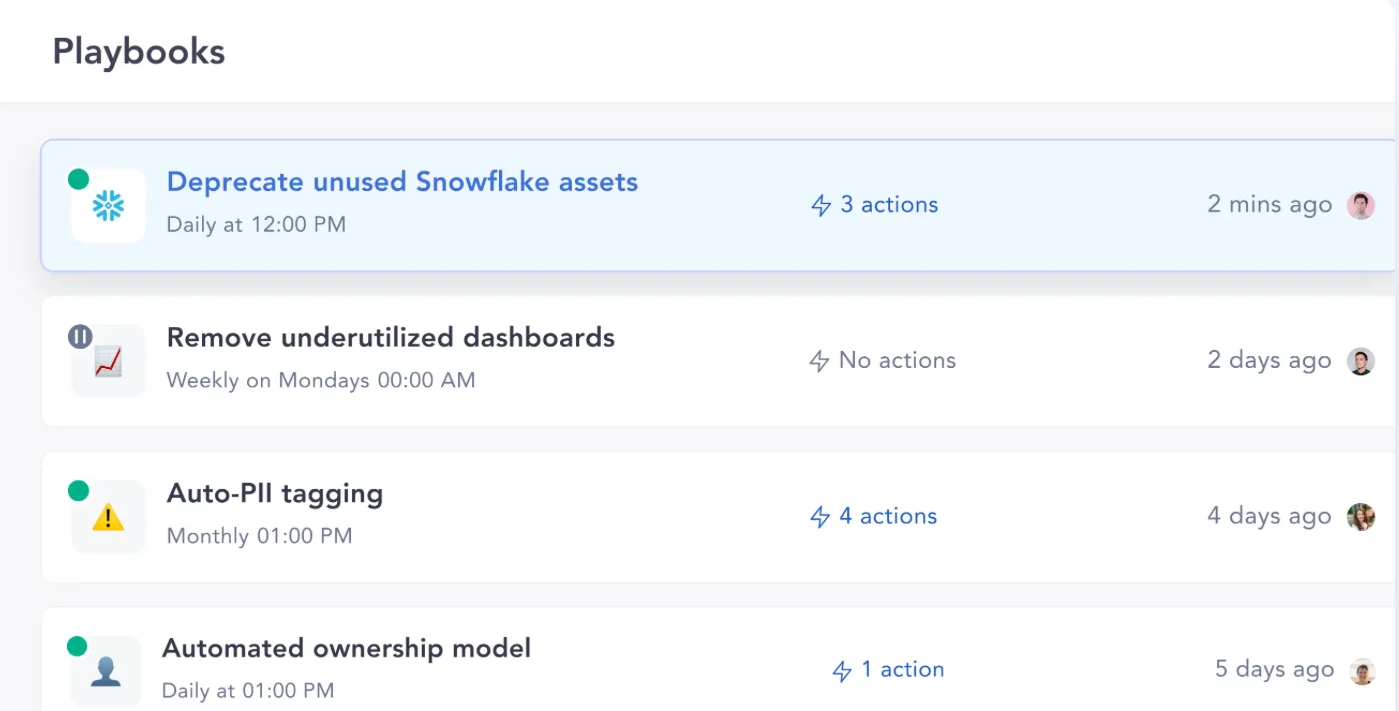
An example of rule-based automation to scale your data governance efforts - Source: Atlan.
3. Open-by-design and extensible for future-proof governance
Permalink to “3. Open-by-design and extensible for future-proof governance”The ideal governance solution must adapt to future challenges—not just react to them. This requires a governance operating model that is:
- Incorporating change as a feature
- Open by default
- Capable of incorporating shifts like AI
- A flexible foundation for “current knowns and future unknowns”
So, look for a data governance solution that lets you create an extensible self-service layer for managing data governance in a single platform. Its open APIs would enable your teams to build custom solutions tailored to your enterprise.
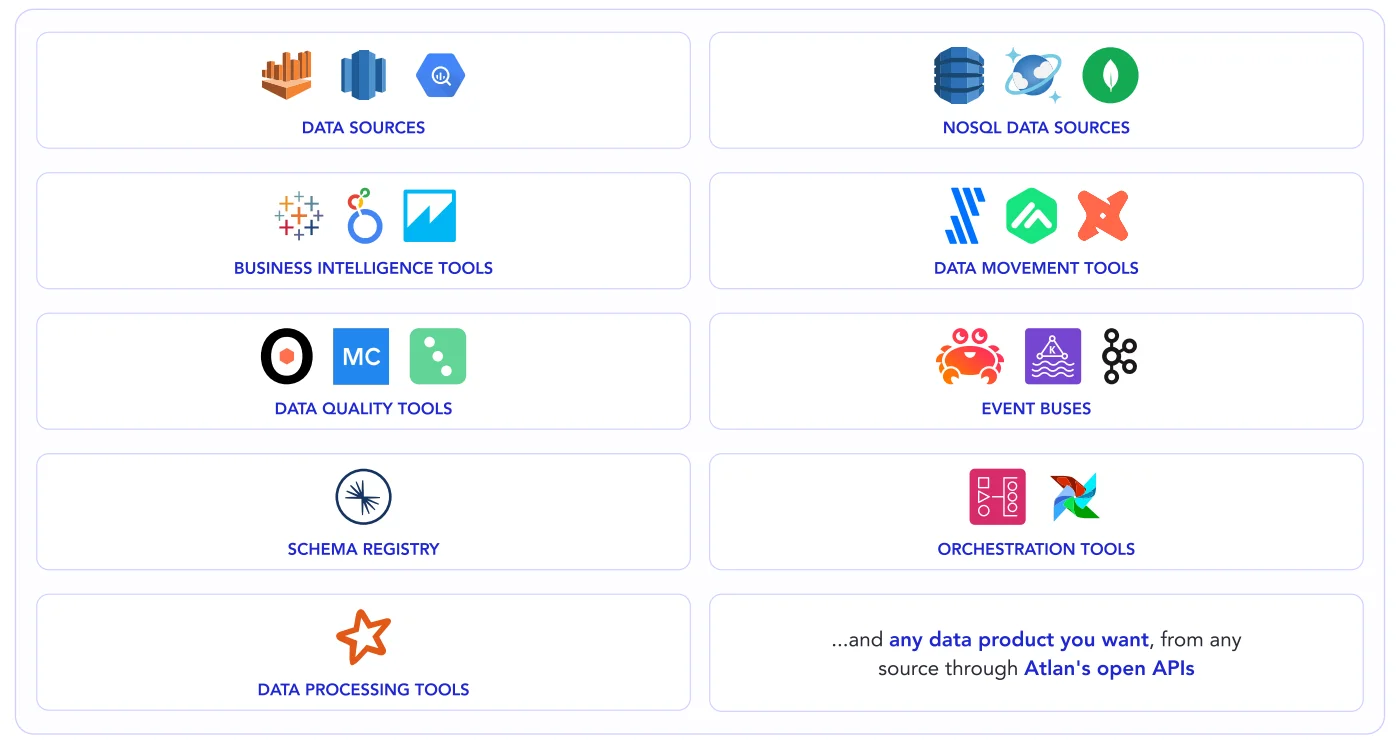
An endlessly open and extensible data governance platform would support numerous tools via open APIs - Source: Atlan.
Such a solution would also provide active, cross-system, column-level data lineage across your data value chain. As a result, you can do the following at scale:
- Trace data’s origins, to assist with root cause analysis, i.e., identifying the underlying causes of a data problem
- Trace data’s destinations, to assist with impact analysis, i.e., identifying potential consequences of changes
- Automate the propagation of metadata to derived assets
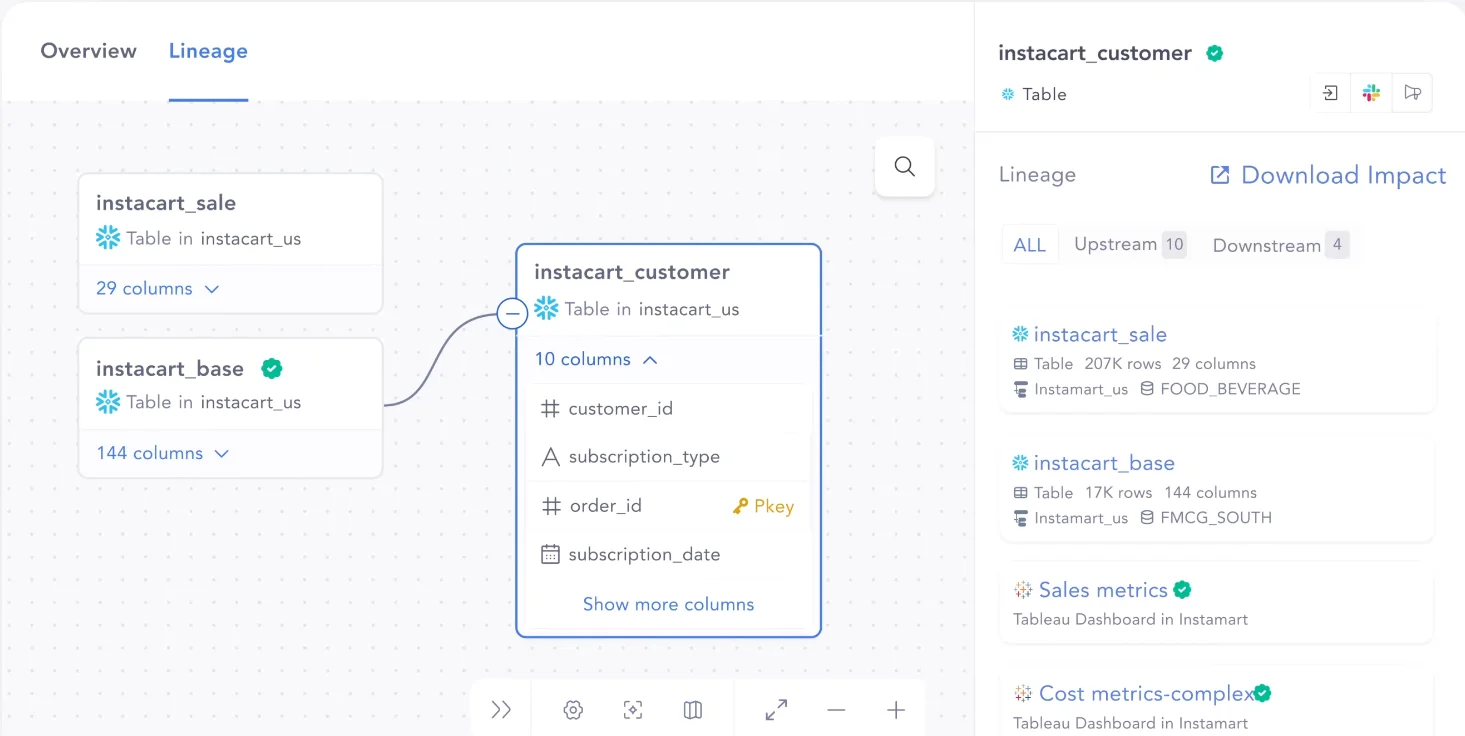
Impact analysis in action - Source: Atlan.
4. Personalized data marketplace for diverse users
Permalink to “4. Personalized data marketplace for diverse users”Data teams have increasingly diverse personas, tools, and outcomes. So, governance cannot be a “one size fits all.” Instead, it should be truly adaptive and flexible to a company’s specific structure.
“[A data governance solution’s] UI should enhance the experience that users have while interacting with the solution/product and ensure that different personas find the appropriate virtual environment in which to work. It should also create a collaborative experience.” - Gartner on the capability of a data governance solution’s UI
Make confident, unified decisions across your organization with a personalized, collaborative home for all things data.
So, the data governance solution you adopt should provide a user interface that’s a personalized, collaborative home for all things data – across multiple clouds, evolving tools, and diverse business functions and personas.
Look for two essential functionalities:
- Data products: Data products establish a common currency by creating a curated, reusable, reproducible, and trusted interface between diverse data personas, tools, and outcomes. They can become the connective tissue between technical and non-technical users and democratize data across domains.
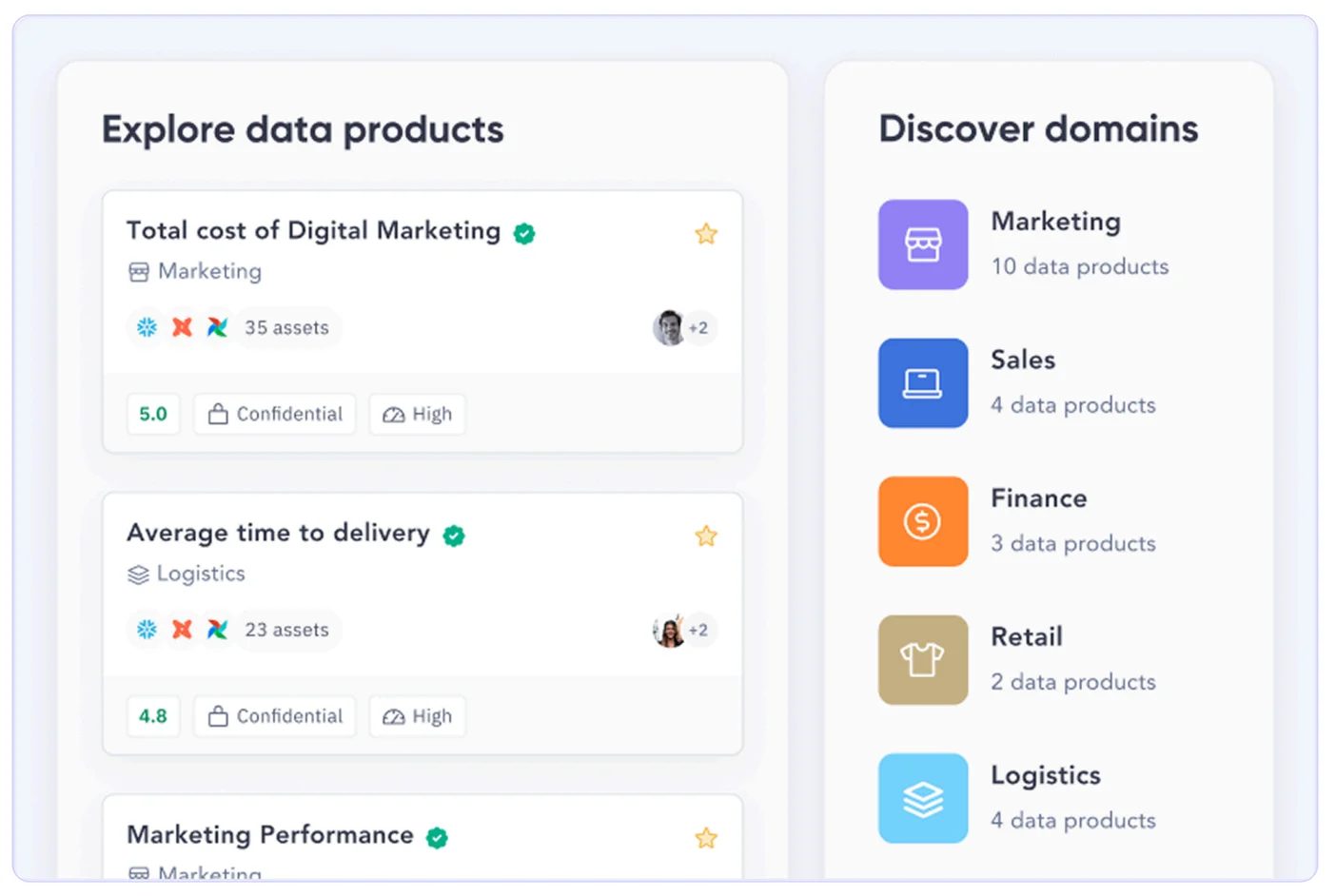
A snapshot of data products and domains in a data governance solution - Source: Atlan.
- Embedded collaboration: Embedded collaboration brings data context (such as metadata and ownership) and data actions (such as approvals and collaboration) to the places where data professionals work daily – inside Slack, Jira, Tableau, etc. For instance, a browser extension can take context from the entire data stack and make it available directly in BI tools (like Tableau) and Snowflake. This metadata-driven context is vital for ensuring the AI-readiness of your enterprise data.
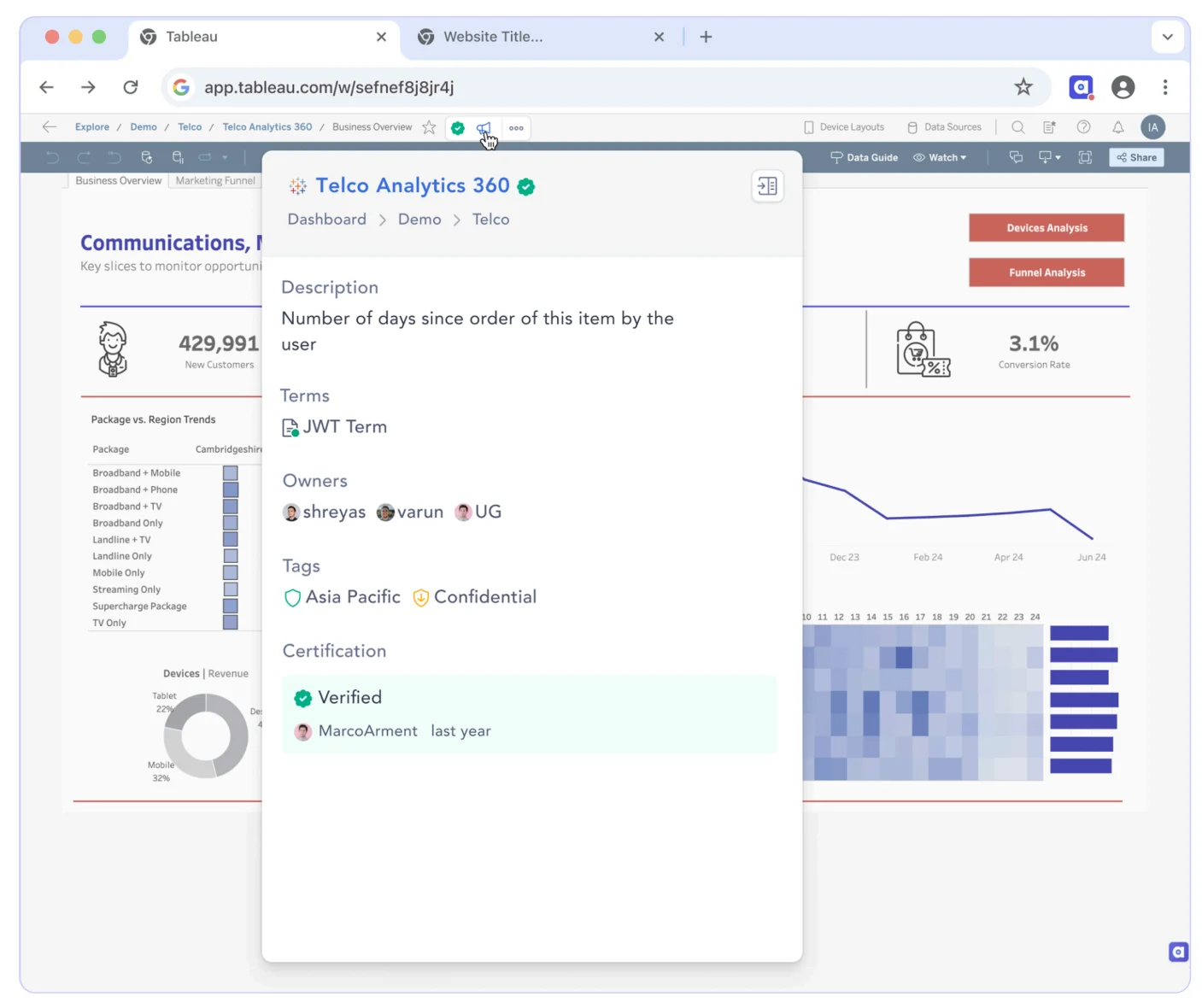
An example of embedded collaboration is a Chrome extension that brings context into BI tools like Tableau - Source: Atlan.
- Personalized data experiences: The user interface of the data governance solution you choose should personalize the data experience to each user persona, business domain, and data project.
Data governance solutions: How Atlan’s metadata control plane is built for change
Permalink to “Data governance solutions: How Atlan’s metadata control plane is built for change”A winning approach to data and AI governance should account for the diversity of any future, rather than betting on one. As complexity increases, the data governance solution you choose should be a visionary partner who understands the technical components as well as the equally-critical people and process elements of your enterprise.
Atlan’s data governance solution is a unified control plane for data, metadata, and AI:
- Personalized for adoption across teams and tools
- Embedded with automation
- Open and extensible with a metadata lakehouse infrastructure
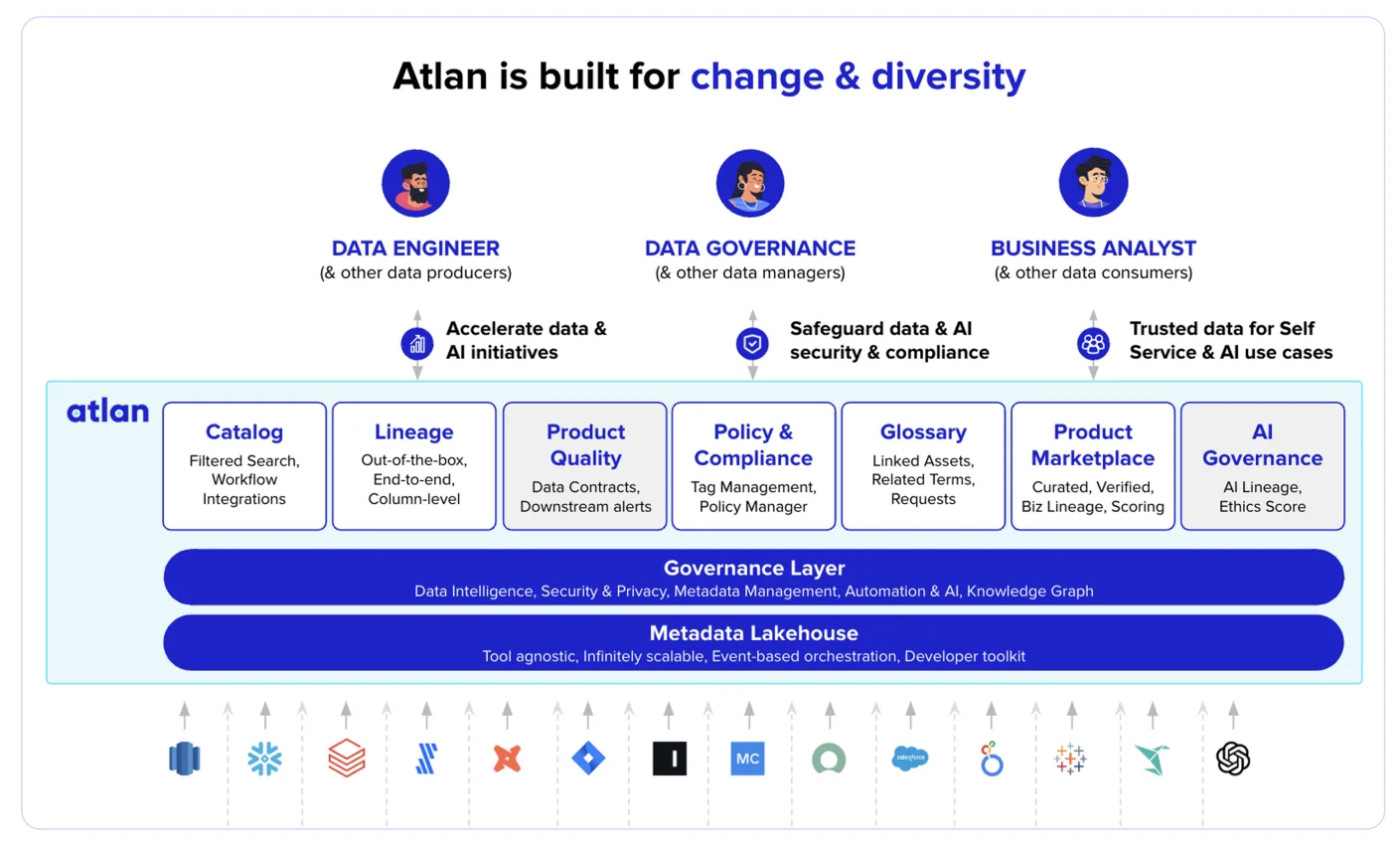
Atlan is a data governance solution built for diverse users, tools, and use cases - Source: Atlan.
Let’s look at two use cases to see Atlan’s unified control plane in action as a comprehensive, future-forward data governance solution.
Case study #1: How North drives millions in value by governing Snowflake with Atlan
Permalink to “Case study #1: How North drives millions in value by governing Snowflake with Atlan”North, a leading payments solution provider processing over $100 billion in annual transactions, has a vast data estate – 225,000 assets, totaling 41 terabytes on Snowflake.
As data volume and variety grew, so did the demand for access, shifting the challenge from mere data accessibility to the more complex issues of data governance and discovery.
With Atlan, North:
- Transformed data discovery by eliminating silos and improving searchability.
- Embedded governance into workflows by integrating the Atlan Chrome Extension with Jira and Slack. As a result, North’s data consumers could raise issues directly in their tool of choice, with a hyperlink to specific assets included automatically.
- Scaled policy enforcement–dynamic data masking at scale–using Atlan Playbooks (rule-based automation).
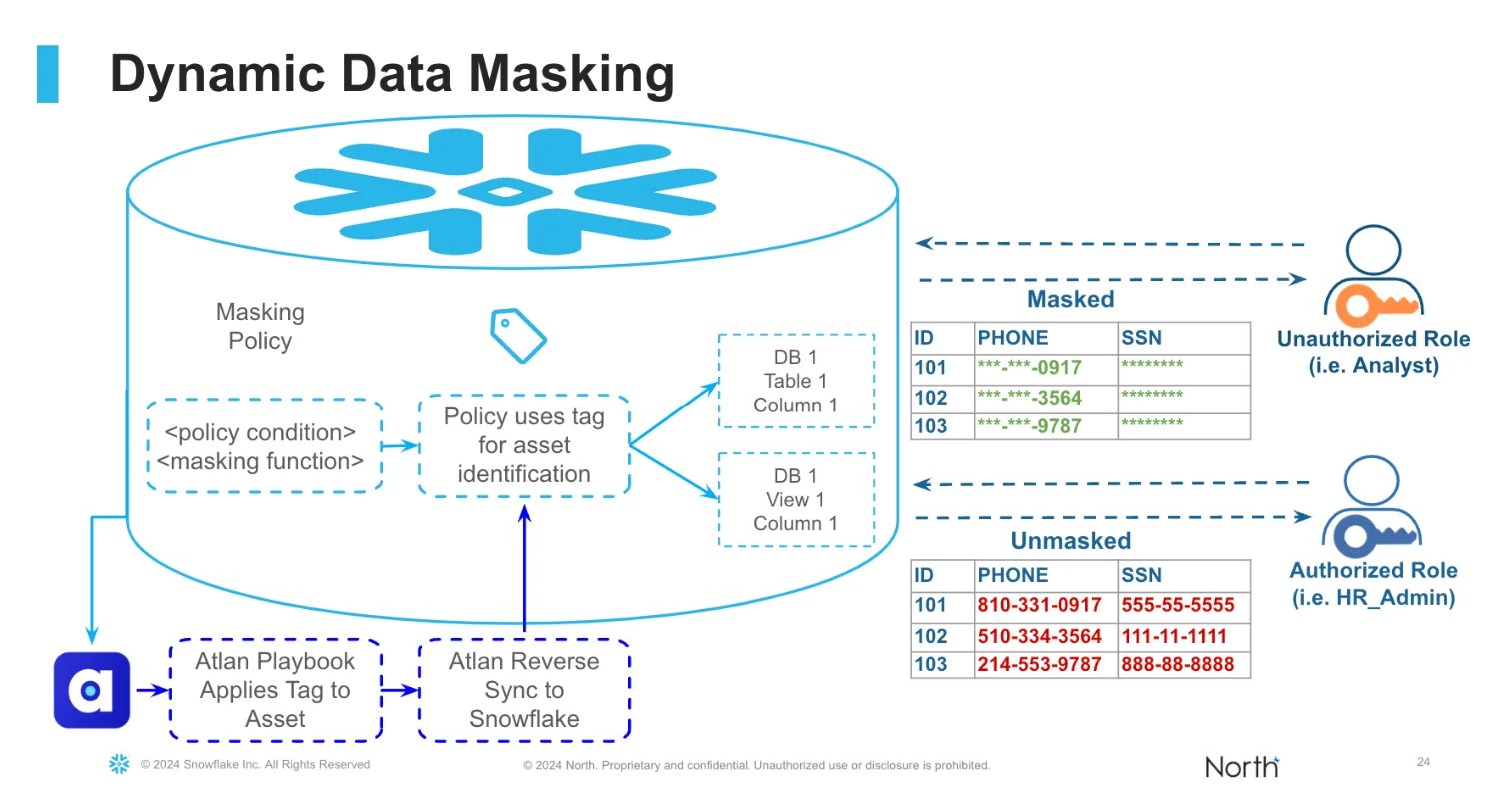
North used Atlan for effective dynamic data masking (DDM) of its Snowflake data assets - Source: Humans of Data.
Business impact: North witnessed $1.4 million in annual efficiency gains and a 700% increase in tagged assets in Snowflake.
Case study #2: How Porto increased data governance team efficiency by 40% with Atlan
Permalink to “Case study #2: How Porto increased data governance team efficiency by 40% with Atlan”Brazilian financial giant Porto has 13,000 employees and 17,000 contractors, serving more than 32,000 brokers and 13 million clients across a diverse set of insurance and banking products and services. Porto’s Data Governance team includes just five members, and they are ultimately responsible for a vast data estate, containing upwards of 1 million assets.
By using Atlan Playbooks, Porto:
- Automated data asset ownership assignments
- Auto-classified PII data to improve LGPD compliance
Business impact: Porto’s five-member Data Governance team has yielded a 40% reduction in time once spent on manual governance tasks.
Data governance solutions: Bottom line
Permalink to “Data governance solutions: Bottom line”As the data landscape rapidly evolves with newer models, tools, personas, and use cases, data governance solutions must adapt to support this environment. The latest data governance trends highlight the industry’s shift toward intelligent, embedded, and open-by-default data governance solutions.
The success stories of North and Porto demonstrate that with Atlan’s metadata control plane, future-forward enterprises can scale governance, improve efficiency, and unlock business value.
Are you looking for a best-in-class data governance solution that’s designed for the diversity of an AI future? If so, give Atlan a spin.
FAQs about data governance solutions
Permalink to “FAQs about data governance solutions”What are the key components of a data governance solution?
Permalink to “What are the key components of a data governance solution?”A data governance solution should include active metadata management, policy setting and enforcement, data lineage mapping, and real-time compliance monitoring.
What factors should you consider when choosing a data governance solution?
Permalink to “What factors should you consider when choosing a data governance solution?”Look for scalability, flexibility, extensibility, personalization, AI capabilities, and an open architecture to adapt to future-proof your governance efforts.
How does a data governance solution help with data access policy setting and enforcement?
Permalink to “How does a data governance solution help with data access policy setting and enforcement?”A data governance solution helps set and enforce data access policies by enabling role-based access controls, automated policy enforcement, and real-time monitoring of policy coverage across your data estate. This helps govern access based on user roles, track violations, and trigger alerts for non-compliance.
How does a data governance solution help with compliance reporting?
Permalink to “How does a data governance solution help with compliance reporting?”A data governance solution streamlines compliance reporting by automating audit trails, tracking policy enforcement, offering cross-system and granular lineage tracking with impact analysis, and providing real-time visibility into policy coverage.
Data governance solutions: Related reads
Permalink to “Data governance solutions: Related reads”- What is Data Governance? Its Importance, Principles & How to Get Started?
- Data Governance Framework: Examples, Templates, Standards, Best Practices & How to Create One?
- Key Objectives of Data Governance: How Should You Think About Them?
- Data Governance Strategy: How To Get Started?
- How to Implement Data Governance: Steps, Prerequisites, Essential Factors & Business Case
- How to Improve Data Governance: Steps, Tips & Template
- 7 Steps to Simplify Data Governance for Your Entire Organization
- Automated Data Governance: How Does It Help You Manage Access, Security & More at Scale?
- Enterprise Data Governance Basics, Strategy, Key Challenges, Benefits & Best Practices
- Data Governance and Compliance: An Act of Checks & Balances
- Data Compliance Management in 2025
- Data Governance and GDPR: A Comprehensive Guide to Achieving Regulatory Compliance
- Data Governance in Banking: Benefits, Challenges, Capabilities
- Financial Data Governance: Strategies, Trends, Best Practices
- BCBS 239 Data Governance: What Banks Need to Know in 2025
- Data Governance & Business Intelligence: Why Their Integration Matters and How It is Crucial for Business Success?
- Unified Control Plane for Data: The Future of Data Cataloging
Share this article

